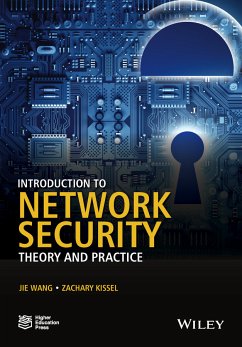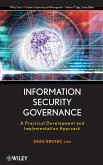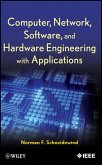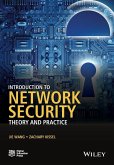

Alle Infos zum eBook verschenken

- Format: ePub
- Merkliste
- Auf die Merkliste
- Bewerten Bewerten
- Teilen
- Produkt teilen
- Produkterinnerung
- Produkterinnerung

Hier können Sie sich einloggen

Bitte loggen Sie sich zunächst in Ihr Kundenkonto ein oder registrieren Sie sich bei bücher.de, um das eBook-Abo tolino select nutzen zu können.
Introductory textbook in the important area of network security for undergraduate and graduate students * Comprehensively covers fundamental concepts with newer topics such as electronic cash, bit-coin, P2P, SHA-3, E-voting, and Zigbee security * Fully updated to reflect new developments in network security * Introduces a chapter on Cloud security, a very popular and essential topic * Uses everyday examples that most computer users experience to illustrate important principles and mechanisms * Features a companion website with Powerpoint slides for lectures and solution manuals to selected…mehr
- Geräte: eReader
- mit Kopierschutz
- eBook Hilfe
- Größe: 29.74MB
![IP Address Management (eBook, ePUB) IP Address Management (eBook, ePUB)]() Timothy RooneyIP Address Management (eBook, ePUB)116,99 €
Timothy RooneyIP Address Management (eBook, ePUB)116,99 €![Information Security Governance (eBook, ePUB) Information Security Governance (eBook, ePUB)]() Krag BrotbyInformation Security Governance (eBook, ePUB)91,99 €
Krag BrotbyInformation Security Governance (eBook, ePUB)91,99 €![Computer, Network, Software, and Hardware Engineering with Applications (eBook, ePUB) Computer, Network, Software, and Hardware Engineering with Applications (eBook, ePUB)]() Norman F. SchneidewindComputer, Network, Software, and Hardware Engineering with Applications (eBook, ePUB)137,99 €
Norman F. SchneidewindComputer, Network, Software, and Hardware Engineering with Applications (eBook, ePUB)137,99 €![Cloud Services, Networking, and Management (eBook, ePUB) Cloud Services, Networking, and Management (eBook, ePUB)]() Cloud Services, Networking, and Management (eBook, ePUB)109,99 €
Cloud Services, Networking, and Management (eBook, ePUB)109,99 €![Introduction to Network Security (eBook, PDF) Introduction to Network Security (eBook, PDF)]() Jie WangIntroduction to Network Security (eBook, PDF)111,99 €
Jie WangIntroduction to Network Security (eBook, PDF)111,99 €![Evolutionary Algorithms for Mobile Ad Hoc Networks (eBook, ePUB) Evolutionary Algorithms for Mobile Ad Hoc Networks (eBook, ePUB)]() Bernabé DorronsoroEvolutionary Algorithms for Mobile Ad Hoc Networks (eBook, ePUB)97,99 €
Bernabé DorronsoroEvolutionary Algorithms for Mobile Ad Hoc Networks (eBook, ePUB)97,99 €![Network Science (eBook, ePUB) Network Science (eBook, ePUB)]() Carlos Andre Reis PinheiroNetwork Science (eBook, ePUB)76,99 €
Carlos Andre Reis PinheiroNetwork Science (eBook, ePUB)76,99 €-
-
-
Dieser Download kann aus rechtlichen Gründen nur mit Rechnungsadresse in A, B, BG, CY, CZ, D, DK, EW, E, FIN, F, GR, HR, H, IRL, I, LT, L, LR, M, NL, PL, P, R, S, SLO, SK ausgeliefert werden.
- Produktdetails
- Verlag: John Wiley & Sons
- Seitenzahl: 440
- Erscheinungstermin: 10. Juli 2015
- Englisch
- ISBN-13: 9781118939505
- Artikelnr.: 43419701
- Verlag: John Wiley & Sons
- Seitenzahl: 440
- Erscheinungstermin: 10. Juli 2015
- Englisch
- ISBN-13: 9781118939505
- Artikelnr.: 43419701
- Herstellerkennzeichnung Die Herstellerinformationen sind derzeit nicht verfügbar.
About the Authors xix
1 Network Security Overview 1
1.1 Mission and Definitions 1
1.2 Common Attacks and Defense Mechanisms 3
1.2.1 Eavesdropping 3
1.2.2 Cryptanalysis 4
1.2.3 Password Pilfering 5
1.2.4 Identity Spoofing 13
1.2.5 Buffer-Overflow Exploitations 16
1.2.6 Repudiation 18
1.2.7 Intrusion 19
1.2.8 Traffic Analysis 19
1.2.9 Denial of Service Attacks 20
1.2.10 Malicious Software 22
1.3 Attacker Profiles 25
1.3.1 Hackers 25
1.3.2 Script Kiddies 26
1.3.3 Cyber Spies 26
1.3.4 Vicious Employees 27
1.3.5 Cyber Terrorists 27
1.3.6 Hypothetical Attackers 27
1.4 Basic Security Model 27
1.5 Security Resources 29
1.5.1 CERT 29
1.5.2 SANS Institute 29
1.5.3 Microsoft Security 29
1.5.4 NTBugtraq 29
1.5.5 Common Vulnerabilities and Exposures 30
1.6 Closing Remarks 30
1.7 Exercises 30
1.7.1 Discussions 30
1.7.2 Homework 31
2 Data Encryption Algorithms 45
2.1 Data Encryption Algorithm Design Criteria 45
2.1.1 ASCII Code 46
2.1.2 XOR Encryption 46
2.1.3 Criteria of Data Encryptions 48
2.1.4 Implementation Criteria 50
2.2 Data Encryption Standard 50
2.2.1 Feistel's Cipher Scheme 50
2.2.2 DES Subkeys 52
2.2.3 DES Substitution Boxes 54
2.2.4 DES Encryption 55
2.2.5 DES Decryption and Correctness Proof 57
2.2.6 DES Security Strength 58
2.3 Multiple DES 59
2.3.1 Triple-DES with Two Keys 59
2.3.2 2DES and 3DES/3 59
2.3.3 Meet-in-the-Middle Attacks on 2DES 60
2.4 Advanced Encryption Standard 61
2.4.1 AES Basic Structures 61
2.4.2 AES S-Boxes 63
2.4.3 AES-128 Round Keys 65
2.4.4 Add Round Keys 66
2.4.5 Substitute-Bytes 67
2.4.6 Shift-Rows 67
2.4.7 Mix-Columns 67
2.4.8 AES-128 Encryption 68
2.4.9 AES-128 Decryption and Correctness Proof 69
2.4.10 Galois Fields 70
2.4.11 Construction of the AES S-Box and Its Inverse 73
2.4.12 AES Security Strength 74
2.5 Standard Block Cipher Modes of Operations 74
2.5.1 Electronic-Codebook Mode 75
2.5.2 Cipher-Block-Chaining Mode 75
2.5.3 Cipher-Feedback Mode 75
2.5.4 Output-Feedback Mode 76
2.5.5 Counter Mode 76
2.6 Offset Codebook Mode of Operations 77
2.6.1 Basic Operations 77
2.6.2 OCB Encryption and Tag Generation 78
2.6.3 OCB Decryption and Tag Verification 79
2.7 Stream Ciphers 80
2.7.1 RC4 Stream Cipher 80
2.7.2 RC4 Security Weaknesses 81
2.8 Key Generations 83
2.8.1 ANSI X9.17 PRNG 83
2.8.2 BBS Pseudorandom Bit Generator 83
2.9 Closing Remarks 84
2.10 Exercises 85
2.10.1 Discussions 85
2.10.2 Homework 85
3 Public-Key Cryptography and Key Management 93
3.1 Concepts of Public-Key Cryptography 93
3.2 Elementary Concepts and Theorems in Number Theory 95
3.2.1 Modular Arithmetic and Congruence Relations 96
3.2.2 Modular Inverse 96
3.2.3 Primitive Roots 98
3.2.4 Fast Modular Exponentiation 98
3.2.5 Finding Large Prime Numbers 100
3.2.6 The Chinese Remainder Theorem 101
3.2.7 Finite Continued Fractions 102
3.3 D
About the Authors xix
1 Network Security Overview 1
1.1 Mission and Definitions 1
1.2 Common Attacks and Defense Mechanisms 3
1.2.1 Eavesdropping 3
1.2.2 Cryptanalysis 4
1.2.3 Password Pilfering 5
1.2.4 Identity Spoofing 13
1.2.5 Buffer-Overflow Exploitations 16
1.2.6 Repudiation 18
1.2.7 Intrusion 19
1.2.8 Traffic Analysis 19
1.2.9 Denial of Service Attacks 20
1.2.10 Malicious Software 22
1.3 Attacker Profiles 25
1.3.1 Hackers 25
1.3.2 Script Kiddies 26
1.3.3 Cyber Spies 26
1.3.4 Vicious Employees 27
1.3.5 Cyber Terrorists 27
1.3.6 Hypothetical Attackers 27
1.4 Basic Security Model 27
1.5 Security Resources 29
1.5.1 CERT 29
1.5.2 SANS Institute 29
1.5.3 Microsoft Security 29
1.5.4 NTBugtraq 29
1.5.5 Common Vulnerabilities and Exposures 30
1.6 Closing Remarks 30
1.7 Exercises 30
1.7.1 Discussions 30
1.7.2 Homework 31
2 Data Encryption Algorithms 45
2.1 Data Encryption Algorithm Design Criteria 45
2.1.1 ASCII Code 46
2.1.2 XOR Encryption 46
2.1.3 Criteria of Data Encryptions 48
2.1.4 Implementation Criteria 50
2.2 Data Encryption Standard 50
2.2.1 Feistel's Cipher Scheme 50
2.2.2 DES Subkeys 52
2.2.3 DES Substitution Boxes 54
2.2.4 DES Encryption 55
2.2.5 DES Decryption and Correctness Proof 57
2.2.6 DES Security Strength 58
2.3 Multiple DES 59
2.3.1 Triple-DES with Two Keys 59
2.3.2 2DES and 3DES/3 59
2.3.3 Meet-in-the-Middle Attacks on 2DES 60
2.4 Advanced Encryption Standard 61
2.4.1 AES Basic Structures 61
2.4.2 AES S-Boxes 63
2.4.3 AES-128 Round Keys 65
2.4.4 Add Round Keys 66
2.4.5 Substitute-Bytes 67
2.4.6 Shift-Rows 67
2.4.7 Mix-Columns 67
2.4.8 AES-128 Encryption 68
2.4.9 AES-128 Decryption and Correctness Proof 69
2.4.10 Galois Fields 70
2.4.11 Construction of the AES S-Box and Its Inverse 73
2.4.12 AES Security Strength 74
2.5 Standard Block Cipher Modes of Operations 74
2.5.1 Electronic-Codebook Mode 75
2.5.2 Cipher-Block-Chaining Mode 75
2.5.3 Cipher-Feedback Mode 75
2.5.4 Output-Feedback Mode 76
2.5.5 Counter Mode 76
2.6 Offset Codebook Mode of Operations 77
2.6.1 Basic Operations 77
2.6.2 OCB Encryption and Tag Generation 78
2.6.3 OCB Decryption and Tag Verification 79
2.7 Stream Ciphers 80
2.7.1 RC4 Stream Cipher 80
2.7.2 RC4 Security Weaknesses 81
2.8 Key Generations 83
2.8.1 ANSI X9.17 PRNG 83
2.8.2 BBS Pseudorandom Bit Generator 83
2.9 Closing Remarks 84
2.10 Exercises 85
2.10.1 Discussions 85
2.10.2 Homework 85
3 Public-Key Cryptography and Key Management 93
3.1 Concepts of Public-Key Cryptography 93
3.2 Elementary Concepts and Theorems in Number Theory 95
3.2.1 Modular Arithmetic and Congruence Relations 96
3.2.2 Modular Inverse 96
3.2.3 Primitive Roots 98
3.2.4 Fast Modular Exponentiation 98
3.2.5 Finding Large Prime Numbers 100
3.2.6 The Chinese Remainder Theorem 101
3.2.7 Finite Continued Fractions 102
3.3 D







